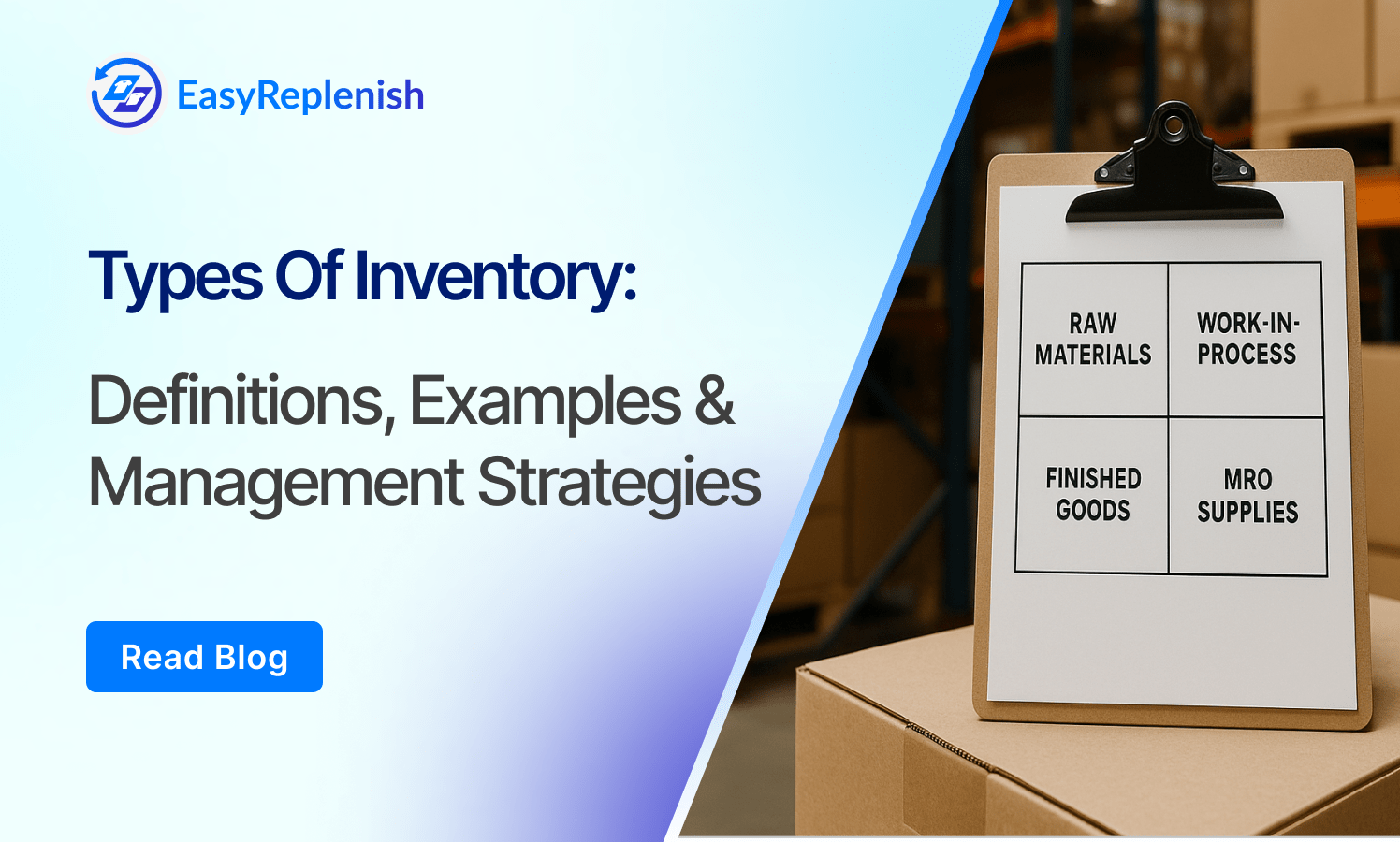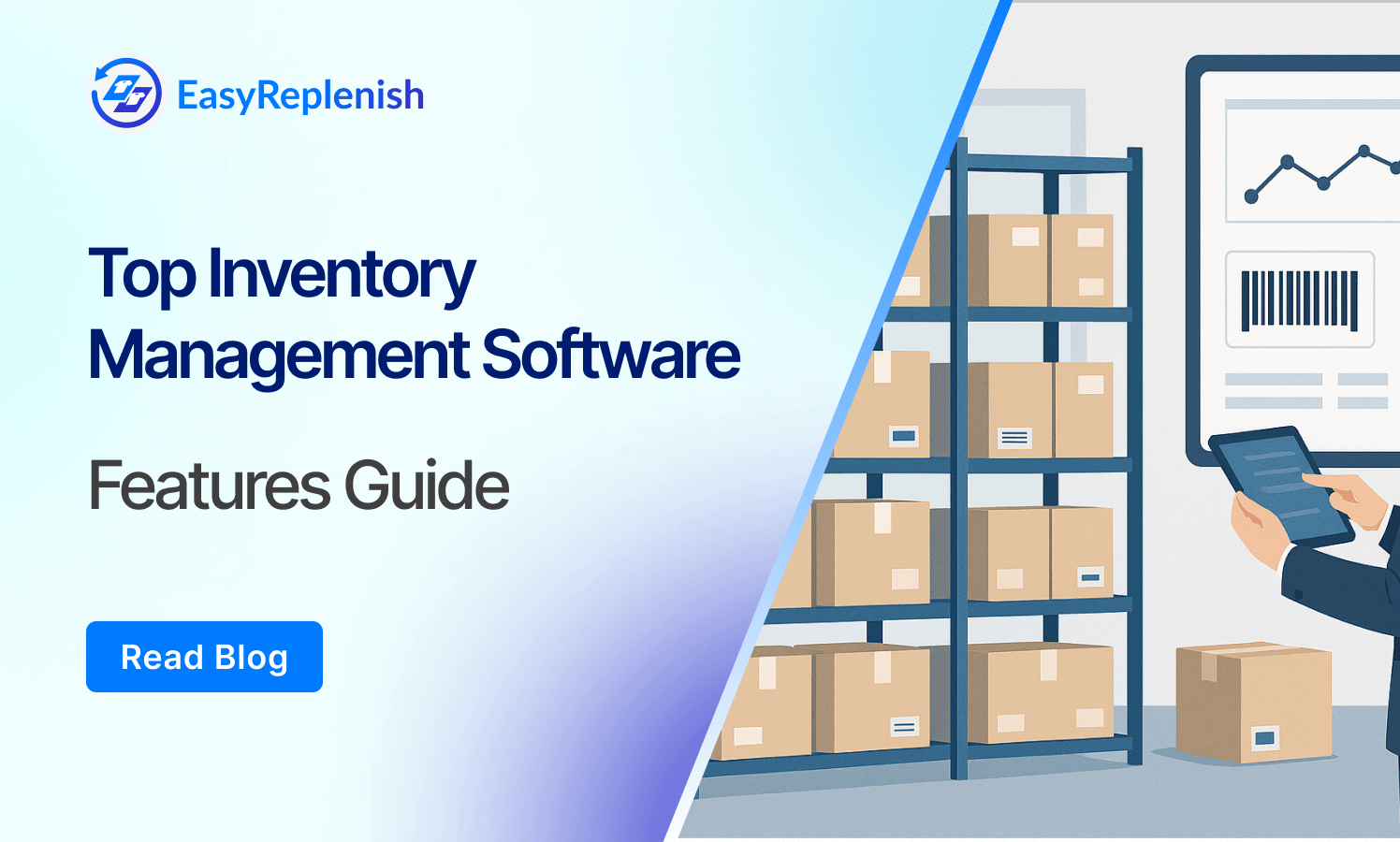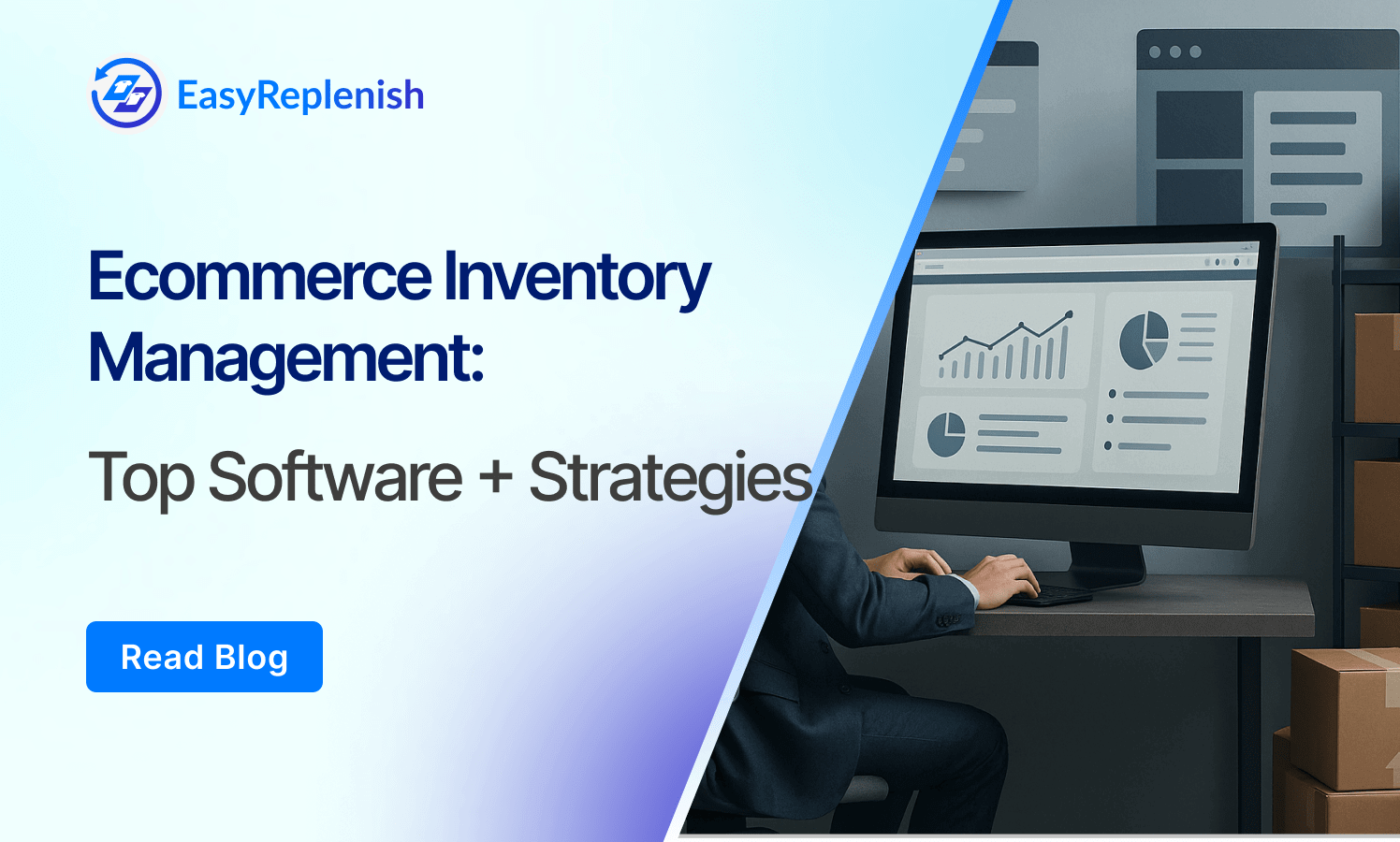Types of Inventory: Definitions, Examples & Management Strategies

Every business holds inventory — but few truly understand it. Ask a retailer what’s in stock and they’ll tell you a number. Ask a manufacturer and you’ll get a production schedule. But dig deeper and you’ll find that inventory isn’t a single pile of goods. It’s a mix of raw materials, work-in-progress, safety buffers, seasonal surpluses, and sometimes, products that will never sell.
The problem? Treating all of it the same way leads to costly mistakes. You end up over-investing in the wrong stock, understocking what sells, or letting capital sit idle in items that don’t move.
Classifying inventory into clear, actionable categories changes that. It gives you the visibility to plan smarter, order at the right time, and keep your capital working where it delivers the most return. Whether you’re a manufacturer fine-tuning your production flow, a retailer managing seasonal swings, or a distributor balancing stock across regions, understanding your inventory types is the first step toward better control.
In this guide, we’ll break down the core categories and specialized types, show where each fits in the business cycle, and outline how this knowledge can drive stronger operational and financial performance.
Understanding Inventory Classification
Inventory classification is more than a neat way to label stock — it’s a framework for how you buy, store, move, and account for goods. When you break your inventory into clear types, you’re not just organizing a warehouse; you’re defining how money flows through your business.
Different inventory categories behave differently. Raw materials tie up cash long before a sale happens. Finished goods are revenue waiting to be realized. Safety stock is an insurance policy against supply chain hiccups. Treating them all as one giant pool of “inventory” blurs the real picture and leads to poor planning.
A solid classification system helps you:
- Forecast accurately by matching each type’s lead time and demand patterns.
- Control costs by applying the right stocking strategy to the right category.
- Improve reporting by separating investment-heavy items from faster-moving stock.
The upcoming sections break down the main inventory types you’ll encounter in most businesses, along with specialized categories that often hide in the background — but still impact profitability.
1. Raw Materials
What it is:
Raw materials are the foundational inputs that are transformed into finished products. They fall into two main categories:
- Direct materials: Core components that become part of the final product (e.g., leather for handbags, steel for car frames).
- Indirect materials: Items used in the production process but not part of the final product (e.g., lubricants for machinery, cleaning supplies for production lines).
Operational impact:
Managing raw materials effectively is critical because they often have long lead times and may come from global suppliers vulnerable to currency fluctuations, geopolitical risk, or seasonal constraints. Poor visibility can lead to costly last-minute purchasing or production shutdowns.
Financial considerations:
Raw materials represent an upstream investment in the supply chain. Money spent here won’t generate returns until production is complete and goods are sold. Overstocking ties up working capital and increases storage costs; understocking stalls production and leads to delayed revenue recognition.
Strategic value:
A well-managed raw material inventory can be a competitive advantage. Brands that secure reliable supply during shortages can maintain production and win market share when competitors can’t.
Example:
A denim apparel brand sources specialty fabric from Italy with a 12-week lead time. By using rolling demand forecasts and supplier contracts, they ensure raw materials arrive just before production needs them — keeping warehouse costs low while protecting production schedules.
2. Work-in-Progress (WIP)
What it is:
Work-in-progress inventory includes partially completed goods at various stages of the production process. It covers raw materials that have entered production but are not yet finished or ready for sale.
Operational impact:
WIP ties up both materials and labor without generating revenue. Excess WIP often indicates process inefficiencies, such as bottlenecks at specific workstations, unbalanced production scheduling, or unnecessary batch sizes.
Financial considerations:
High WIP levels inflate your balance sheet without adding liquidity. In industries with complex assembly, WIP also hides hidden costs — rework, scrap, and the cost of holding semi-finished goods in climate-controlled storage.
Strategic value:
Lean manufacturing practices aim to keep WIP minimal, which reduces lead times and improves responsiveness to demand changes. Conversely, some businesses deliberately hold higher WIP to smooth production during demand fluctuations or raw material shortages.
Example:
A furniture manufacturer has 150 dining tables awaiting varnish in its finishing area. This ties up raw materials, labor hours, and storage space — all without a single sale booked. By introducing a balanced production schedule and cross-training staff, they reduce WIP by 40%, freeing capital and accelerating order fulfillment.
3. Finished Goods
What it is:
Finished goods are products that have completed the manufacturing process and are ready for sale to customers. For retailers, they’re the stock sitting in stores or warehouses; for manufacturers, they’re the products awaiting shipment to distributors or customers.
Operational impact:
Finished goods determine your ability to meet customer demand immediately. Overstock leads to high carrying costs, increased risk of obsolescence, and markdown pressure; understock leads to stockouts, lost sales, and potential customer churn.
Financial considerations:
Finished goods tie up both production costs and overhead. In industries with rapid product cycles (e.g., electronics, fashion), holding excess finished goods can result in sharp value depreciation as new models or styles replace older ones.
Strategic value:
Right-sizing finished goods inventory can improve customer satisfaction, cash flow, and competitiveness. Businesses with the agility to scale finished goods up or down quickly can better respond to seasonal peaks or sudden market shifts.
Example:
An e-commerce electronics retailer maintains a two-week supply of smartphones based on sales velocity. When a new model launches, they immediately reduce replenishment orders for older models, clearing stock before value drops — while still meeting ongoing demand.
4. Maintenance, Repair, and Operations (MRO) Inventory
What it is:
MRO inventory includes the consumables, tools, and spare parts needed to keep business operations running but that don’t directly form part of the finished product. This can include everything from lubricants, cleaning supplies, and safety equipment to spare machine components and basic office supplies.
Operational impact:
While MRO items don’t generate revenue directly, their absence can halt operations. A missing machine belt or lack of protective gloves can stop production lines or violate safety regulations. Effective MRO control ensures maintenance teams have what they need without overstocking low-turnover items.
Financial considerations:
MRO inventory often hides in plain sight. Because individual items are inexpensive, many companies neglect tracking — leading to unnoticed waste, duplication, or emergency rush orders at premium prices. These unplanned costs add up over time.
Strategic value:
A well-managed MRO program can reduce downtime, extend equipment life, and improve compliance with safety and regulatory standards. For asset-intensive industries, MRO control is as critical as managing raw materials.
Example:
A packaging plant introduced a barcode-based MRO tracking system. By standardizing suppliers and centralizing stock, they cut emergency purchases by 30% and reduced downtime caused by missing tools or parts.
5. Transit Inventory (Pipeline Inventory)
What it is:
Transit inventory refers to goods that have been shipped from a supplier or warehouse but have not yet arrived at their final destination. These can be raw materials en route to a factory or finished goods traveling to a distribution center or retail store.
Operational impact:
Transit inventory affects your true stock visibility. If not tracked accurately, you risk reordering unnecessarily or running out before goods arrive. Long transit times can complicate replenishment cycles, especially for imported goods.
Financial considerations:
Even while in motion, transit inventory ties up working capital and may incur additional costs such as insurance, freight fees, and customs duties. Delays can create a domino effect — missing production windows, delaying deliveries, and damaging customer relationships.
Strategic value:
Businesses that closely monitor transit inventory can better align production schedules, avoid last-minute expedited shipping, and reduce carrying costs by optimizing lead times.
Example:
A furniture retailer sources sofas from overseas manufacturers. By integrating freight tracking data with their ERP, they can see exactly when goods will arrive, adjust marketing campaigns accordingly, and avoid both premature markdowns and stockouts.
6. Safety Stock
What it is:
Safety stock is the extra inventory kept as a buffer against demand spikes, supply chain delays, or forecast inaccuracies. It’s not intended for regular sales — it’s a contingency reserve.
Operational impact:
Safety stock shields businesses from disruptions but requires careful balance. Too little means stockouts during unexpected demand surges; too much increases storage costs and risks obsolescence.
Financial considerations:
Holding safety stock ties up capital without guaranteed turnover. However, the cost of holding it is often far less than the cost of lost sales, production stoppages, or customer churn caused by running out.
Strategic value:
Safety stock acts as a form of risk management. Businesses with volatile demand or unreliable suppliers often maintain higher safety stock to protect service levels, while those with stable demand may keep it minimal.
Example:
A hardware store sells 20 units of a specific drill per day and usually receives supplier shipments within 5 days. They maintain a safety stock of 100 units so they can continue selling even if deliveries are delayed by a week.
7. Cycle Stock
What it is:
Cycle stock is the portion of inventory that a business expects to sell or use within a given period under normal demand conditions. It’s replenished regularly as part of routine ordering and production cycles.
Operational impact:
Cycle stock reflects your baseline demand and determines how often you reorder. If calculated incorrectly, you either tie up cash in excess inventory or risk frequent shortages. Cycle stock is closely tied to Economic Order Quantity (EOQ) calculations and replenishment schedules.
Financial considerations:
Holding cycle stock is inevitable, but overestimating it inflates carrying costs, while underestimating it drives up ordering costs and emergency procurement expenses. Striking the right balance keeps operations smooth without excess capital tied up.
Strategic value:
By optimizing cycle stock, businesses can standardize replenishment cycles, reduce procurement workload, and negotiate better supplier terms. Accurate cycle stock management also helps prevent overproduction in manufacturing.
Example:
A beverage distributor knows that a supermarket chain orders 1,000 cases of sparkling water every month. They maintain cycle stock to match this recurring demand, placing bulk orders quarterly to reduce freight costs.
8. Decoupling Inventory
What it is:
Decoupling inventory is the stock kept between different stages of production to prevent one process from stalling if another is delayed. It acts as a buffer between dependent manufacturing steps.
Operational impact:
In multi-step production environments, delays in one stage can halt the entire process. Decoupling inventory keeps downstream operations running while upstream issues are resolved, improving production continuity.
Financial considerations:
Decoupling inventory ties up capital in semi-finished goods but can significantly reduce downtime costs. The financial trade-off is between the cost of holding the buffer and the potential loss from idle labor or missed delivery deadlines.
Strategic value:
Businesses with complex, interdependent production processes often keep decoupling inventory to protect delivery commitments. It also supports flexibility when switching between product variants without halting the entire line.
Example:
An automotive parts manufacturer keeps a buffer of pre-assembled gearboxes between machining and final assembly. Even if machining slows due to maintenance, assembly can continue meeting production schedules.
9. Anticipation Inventory
What it is:
Anticipation inventory is stock built up in advance of a predictable increase in demand, a major promotional event, or a potential supply disruption. It’s common in industries with strong seasonality or where supply chain constraints are anticipated.
Operational impact:
Anticipation inventory allows businesses to meet high demand without overloading production or distribution systems during peak periods. It also cushions against expected supply shortages, raw material delays, or labor strikes.
Financial considerations:
While it ties up capital ahead of actual sales, anticipation inventory can prevent costly lost sales and help businesses negotiate better supplier pricing when buying in bulk off-peak. However, misjudging demand can lead to overstocks, markdowns, and higher carrying costs.
Strategic value:
Proactive anticipation inventory can secure market share during peak seasons by ensuring availability when competitors may be sold out. It’s also a hedge against raw material cost inflation.
Example:
A toy manufacturer ramps up production six months before the holiday season, building anticipation inventory to ensure retailers are fully stocked when holiday shopping surges in November and December.
10. Obsolete or Dead Stock
What it is:
Obsolete (or dead) stock refers to inventory that has no realistic chance of being sold at its original value due to product expiration, technological obsolescence, or a shift in customer preferences.
Operational impact:
Dead stock clogs storage space, ties up capital, and can inflate insurance and handling costs. It also distorts inventory reporting if not written down or removed promptly.
Financial considerations:
Carrying dead stock is a pure cost with no return. Businesses often resort to clearance sales, liquidation, or recycling to recover a fraction of the investment. Delaying action increases losses, especially for perishable or fast-depreciating products.
Strategic value:
Minimizing obsolete stock requires accurate demand forecasting, strict product lifecycle monitoring, and disciplined inventory audits. It’s also a reminder that agile inventory management is as much about exit strategies as it is about stocking strategies.
Example:
An electronics retailer still holding last year’s smartphone model after the new version launches faces steep markdowns to clear shelf space. By tracking sell-through rates closely, they can phase out older stock before demand collapses.
How to Identify and Track Different Inventory Types
Knowing the definitions of inventory types is one thing. Recognizing them in your own business and tracking them accurately is where the real operational and financial benefits come in. Without proper classification, you risk applying the wrong management strategy to the wrong stock — leading to higher costs and poorer service levels.
1. Map Inventory to Your Business Processes
Start by aligning inventory categories with their position in your workflow:
- Upstream (before production): Raw materials, anticipation inventory.
- Midstream (during production): Work-in-progress, decoupling inventory.
- Downstream (ready for sale or in transit): Finished goods, cycle stock, safety stock, transit inventory.
- Support functions: MRO inventory.This mapping creates clarity on what each category does and how it contributes to the business cycle.
2. Use SKU-Level Classification in Your ERP or Inventory System
Assign inventory types at the SKU level within your ERP or inventory management software. Tagging items properly ensures accurate reporting, valuation, and replenishment planning. For example, raw materials may need supplier lead-time tracking, while finished goods require demand-based reorder points.
3. Establish Measurement & Valuation Rules for Each Type
Different inventory types need different metrics:
- Raw materials: Lead time, supplier reliability, purchase cost trends.
- WIP: Production stage time, bottleneck frequency, work order completion rate.
- Finished goods: Sell-through rate, gross margin return on inventory (GMROI).
- Safety stock: Days of coverage, service-level achievement. Having type-specific KPIs prevents one-size-fits-all metrics from obscuring operational issues.
4. Implement Periodic Audits & Cycle Counting
Physical verification helps spot misclassification, shrinkage, or excess buildup. A quarterly review of inventory types ensures they still match actual usage patterns. For example, cycle stock creeping into safety stock levels could signal overbuying.
5. Integrate Demand Forecasting and Replenishment Rules
Forecasting models should differentiate between types. Anticipation inventory relies on seasonal or promotional demand planning, while cycle stock is tied to regular demand patterns. Applying the same forecast logic to both will cause either shortages or overstock.
Pro Tip: Businesses with complex operations often maintain hybrid visibility — tracking inventory by type for operational decisions and by value for financial reporting. This ensures both managers and finance teams get the insights they need.
Choosing the Right Strategy for Each Inventory Type
Not every inventory type should be managed the same way. The right approach depends on its role in your business cycle, its impact on cash flow, and how demand behaves. Here’s how to align each type with the right strategy.
1. Raw Materials
Best strategies:
- Supplier relationship management to secure priority supply during shortages.
- Just-in-Time (JIT) or vendor-managed inventory (VMI) for stable demand and reliable suppliers.
- Safety buffer for critical or long-lead-time materials.
Why: Balances capital efficiency with production continuity, especially in global sourcing scenarios.
2. Work-in-Progress (WIP)
Best strategies:
- Lean manufacturing to keep WIP minimal and identify process bottlenecks.
- Balanced scheduling to avoid overproduction at early stages.
- Kanban systems to synchronize workflow between stations.
Why: Lower WIP frees cash, speeds production, and reduces hidden storage costs.
3. Finished Goods
Best strategies:
- Demand-driven replenishment to match stock with sales velocity.
- ABC analysis to prioritize high-value or fast-selling items.
- Dynamic safety stock during seasonal peaks or promotional campaigns.
Why: Keeps availability high without burdening cash flow or risking obsolescence.
4. MRO Inventory
Best strategies:
- Centralized stocking with defined reorder points.
- Usage tracking to prevent waste and theft.
- Standardized procurement for consistent quality and better pricing.
Why: Prevents downtime while keeping low-value but essential items under control.
5. Transit Inventory
Best strategies:
- Real-time tracking integrated with ERP for accurate visibility.
- Lead time optimization by working with logistics providers.
- Consolidated shipments to reduce handling and freight costs.
Why: Improves planning accuracy and reduces the need for excess on-hand inventory.
6. Safety Stock
Best strategies:
- Service-level based calculation to balance availability and cost.
- Dynamic adjustments based on demand volatility and supplier reliability.
- Segmentation so high-value SKUs have more protection than slow movers.
Why: Avoids lost sales without turning the buffer into excess stock.
7. Cycle Stock
Best strategies:
- EOQ-based ordering to minimize total holding and ordering costs.
- Demand monitoring to keep cycle stock aligned with actual usage.
- Supplier lead time coordination for smoother replenishment cycles.
Why: Keeps routine demand flowing without overloading inventory levels.
8. Decoupling Inventory
Best strategies:
- Process time balancing to reduce reliance on buffers.
- Targeted buffer placement only at stages prone to delays.
- Continuous improvement to eliminate root causes of stoppages.
Why: Protects production flow while still encouraging efficiency gains.
9. Anticipation Inventory
Best strategies:
- Seasonal demand forecasting well in advance.
- Pre-negotiated supplier contracts for bulk buying.
- Tight sell-through monitoring to adjust orders if demand changes.
Why: Maximizes sales during peaks without creating large post-season write-downs.
10. Obsolete/Dead Stock
Best strategies:
- Early detection through slow-moving stock reports.
- Liquidation or clearance sales before value drops further.
- Design changes or bundling to recover partial value.
Why: Minimizes financial loss and frees up valuable warehouse space.
Conclusion:
Turning Inventory Classification into a Strategic Advantage
Inventory is more than a number on your balance sheet — it’s a living, moving asset that fuels your ability to serve customers, generate revenue, and grow sustainably. But without clear classification, it’s easy to mismanage. Raw materials get over-ordered, finished goods pile up unsold, and safety stock turns into dead stock.
By understanding the different types of inventory and applying tailored strategies to each, you gain the visibility and control needed to optimize working capital, reduce waste, and improve responsiveness to market shifts. Whether you’re a manufacturer balancing raw materials and WIP, a retailer navigating seasonal demand, or a distributor managing goods in transit, inventory classification is the foundation for better decisions at every level.
Businesses that treat inventory as a strategic asset — not just an operational necessity — are better positioned to cut costs, boost cash flow, and maintain a competitive edge in volatile markets. The more precisely you understand your inventory, the more effectively you can turn it into a growth driver.
FAQs
Q1. Can a business have multiple inventory types at the same time?
Absolutely. In fact, most businesses carry several inventory types simultaneously. A manufacturer might hold raw materials for upcoming production, WIP on the shop floor, finished goods ready for delivery, and MRO supplies for equipment maintenance. Even a small retailer may have finished goods, seasonal anticipation inventory, and a small safety stock buffer. Understanding and tracking each type separately helps you optimize stock levels and manage working capital effectively.
Q2. Which inventory type is most costly to maintain?
The answer depends on your industry, but finished goods often carry the highest ongoing cost because they include all the accumulated material, labor, and overhead expenses from production — and they may depreciate or become obsolete quickly. For high-value manufacturing, WIP can also be costly because capital is tied up in partially completed products that aren’t yet generating revenue. In all cases, excessive holding costs can be reduced with better demand forecasting and replenishment strategies.
Q3. How does knowing your inventory type affect financial reporting?
Inventory classification impacts both valuation and taxation. For example, raw materials and WIP are valued differently than finished goods for accounting purposes. Understanding your mix of inventory types helps you apply the right costing method (FIFO, LIFO, or weighted average), which influences gross margins and taxable income. It also improves inventory turnover analysis and working capital management — key metrics that investors and lenders often scrutinize.
Q4. What is the difference between anticipation inventory and safety stock?
While both act as buffers, they serve different purposes. Anticipation inventory is built up intentionally ahead of a known event — such as seasonal demand peaks, product launches, or expected supplier shortages. Safety stock, on the other hand, is held as a safeguard against unexpected changes, like sudden demand spikes or supplier delays. In short: anticipation inventory is planned for a specific upcoming need, while safety stock is insurance for unpredictable scenarios.
Q5. How often should inventory types be reviewed?
Inventory classification isn’t a one-time exercise. Best practice is to review classifications quarterly and conduct deeper audits annually. Changes in product demand, supplier performance, lead times, or business strategy can shift an item from one category to another. For example, a slow-moving finished good may become obsolete stock, or a seasonal product might require anticipation inventory planning well ahead of peak demand.
Q6. Can inventory types overlap in reporting?
Yes — especially in complex operations. For example, cycle stock and safety stock often coexist for the same SKU, with one portion covering regular demand and the other acting as a buffer. Similarly, WIP may overlap with decoupling inventory in multi-stage manufacturing. The key is clear labeling in ERP systems so reporting stays transparent and replenishment decisions remain accurate.
Q7. Which inventory type is easiest to control?
Typically, MRO inventory is the most straightforward to manage because demand is relatively stable and predictable. However, it’s also the most likely to be overlooked, leading to small but consistent waste. Finished goods and WIP tend to be harder to control because they’re directly tied to unpredictable customer demand and production variability.
Q8. How do inventory types affect supply chain strategy?
Each type demands a different supply chain approach. Raw materials may require long-term supplier contracts, WIP benefits from lean manufacturing practices, finished goods rely on responsive distribution, and safety stock depends on accurate forecasting. A business that understands its inventory mix can align sourcing, production, and distribution strategies to reduce costs while improving service levels.

.png)





